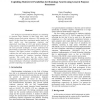Free Online Productivity Tools
i2Speak
i2Symbol
i2OCR
iTex2Img
iWeb2Print
iWeb2Shot
i2Type
iPdf2Split
iPdf2Merge
i2Bopomofo
i2Arabic
i2Style
i2Image
i2PDF
iLatex2Rtf
Sci2ools
ICPADS
2005
IEEE
2005
IEEE
Exploiting Multi-level Parallelism for Homology Search using General Purpose Processors
New biological experimental techniques are continuing to generate large amounts of data using DNA, RNA, human genome and protein sequences. The quantity and quality of data from these experiments makes analyses of their results very time consuming, expensive and impractical. Searching on DNA and protein databases using sequence comparison algorithms has become one of the most powerful techniques to better understand the functionality of particular DNA, RNA, genome, or protein sequence. This paper presents a technique to effectively combine fine and coarse grain parallelism using general purpose processors for sequence homology database searches. The results show that the classic Smith Waterman sequence alignment algorithm achieves super linear performance with proper scheduling and multi level parallel computing at no additional cost.
| Added | 25 Jun 2010 |
| Updated | 25 Jun 2010 |
| Type | Conference |
| Year | 2005 |
| Where | ICPADS |
| Authors | Xiandong Meng, Vipin Chaudhary |
Comments (0)

